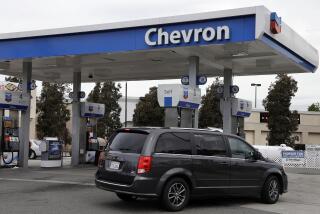Arco Chief Made Overture in BP Amoco Merger
- Share via
Mike R. Bowlin’s start in the oil business was small: sweeping up at his dad’s gasoline station in Amarillo, Texas.
Now Bowlin heads the seventh-largest oil company in the United States. He’s sweeping up again, but the stakes are much higher this time as he prepares to sell Atlantic Richfield Co. to BP Amoco, the world’s third-largest publicly traded oil firm.
The proposed $26.8-billion transaction was announced Thursday.
Bowlin, 56, said he has no future plans other than to continue to steer Los Angeles-based Arco through the challenges of rock-bottom oil prices and fierce competition while the two companies work to complete their merger, which is expected by the end of the year. Then he will leave Arco, his employer for 30 years.
“I tell you what--I’ve been so busy putting this together and we’ve got so long to go before we’re through that I haven’t thought about what I’m going to do,” Bowlin said in an interview .
But Bowlin, who joined Arco in 1969 as a human resources representative in its Dallas office, said he is too young to retire.
“I’ll find something to do,” he said with a laugh. Bowlin said he and his wife, Martha, will keep a house in Los Angeles and are thinking about buying a ranch in Texas--”That’s always been a dream. And then we’ll figure out what I want to do in addition to that.”
Bowlin, who became chief executive in 1994 and chairman the year after, would have plenty of money to do it. His severance package includes a $4.2-million payment based on salary, and bonus and stock options valued at an estimated $29 million, according to a company proxy statement.
The two companies said the merger will result in 2,000 firings. Arco employees who are laid off will be able to choose from several severance packages, Bowlin said.
“I’m very pleased we have been able to be very generous with our employees,” Bowlin said at a news conference Thursday. “I think that shows a sensitivity on the part of BP Amoco.”
Arco employs 18,000 people, with about 3,600 in Southern California.
Bowlin said he called BP Amoco Chief Executive John Browne in January about selling Arco because “we think it creates a really terrific company from our viewpoint, even though it’s a bittersweet moment for us.”
At first, Arco was “Acorn” and BP Amoco was “Oak.” Then they became Wheat and Maize, in the secret codes that surround these sorts of big-money negotiations.
Now, after three months of dickering leading to the $26.8-billion proposed merger agreement, they will be simply BP Amoco. Together, the companies expect to save $1 billion a year.
“Against a background of uncertain oil prices and the increased competitive pressure across the sector, it is clear that the uniquely complementary operations of our companies can compete more effectively together than apart,” Brown said at a news conference in London. It is the eighth oil industry merger in the last six months.
After putting Arco into its tank, BP Amoco would still rank as the world’s third-largest publicly traded oil company in terms of oil and gas reserves as well as revenue. Royal Dutch/Shell and the company resulting from the pending merger of Exxon Corp. and Mobil Corp. are still larger.
But BP Amoco would pump more oil than any other company not owned by a foreign government. And it would become a coast-to-coast gasoline retailer, adding Arco’s strong 1,760-station operation in five Western states to its own network of 15,500 BP and Amoco stations. Arco would continue as a separate brand at least for a while, the two companies said.
With the Arco stations, BP Amoco would control about 13% of the U.S. gasoline market, Browne said. Only a joint venture between Shell USA and Texaco, and the proposed Exxon-Mobil pairing sell more gasoline, with 14.7% and 14.3% of the market respectively, according to the Lundberg Survey, a Camarillo-based research and consulting firm.
With some understatement, Browne said he was “surprised” by Bowlin’s overture so soon after the Dec. 31 close of the $48-billion merger between British Petroleum of London and Amoco Corp. of Chicago. But Browne said he was particularly attracted by Arco’s holdings on Alaska’s North Slope, where BP Amoco already is the dominant player, its gas holdings in Asia and its West Coast oil refining and gasoline business.
The proposed deal, which exchanged 0.82 of a BP Amoco American depositary receipt for each Arco share, is expected to close by the end of the year, the companies said. The deal must be first approved by shareholders and regulatory authorities, included the U.S. Federal Trade Commission and the European Union.
Browne said that BP Amoco expects to sell about $3 billion in assets, including about 300,000 acres in Alaska, to comply with state ownership limits, and Arco’s tanker fleet, which BP Amoco as a foreign corporation is prevented from owning by U.S. law.
(BEGIN TEXT OF INFOBOX / INFOGRAPHIC)
The BP Amoco-Arco Deal
* Purchase price: $26.8 billion, based on the exchange of 0.82 of a BP Amoco American depositary receipt for each Arco share, at March 26 values.
* Layoffs: Initial estimate is 2,000, mostly in Southern California and Texas.
* Gas stations: The Arco name will stay on the pumps, and Arco’s 1,760 gas stations will continue to be the lowest-priced major retailer, at least for now.
* Savings: $1 billion by 2001
More to Read
Inside the business of entertainment
The Wide Shot brings you news, analysis and insights on everything from streaming wars to production — and what it all means for the future.
You may occasionally receive promotional content from the Los Angeles Times.










